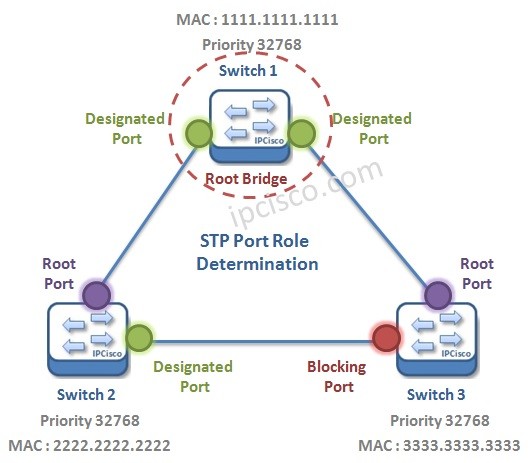- COURSES
- SPECIALS
- BLOG
- MEMBERS
- SHOP
- ABOUT
- ENROLL HERE

Spanning Tree Protocol (STP) Operation is done with various sub processes. In this lesson, we will talk about each of these sub processes and explain STP Operation detailly. We will configure STP with Packet Tracer in another lesson.
Table of Contents
First of all STP gives some specific roles and names to the different switches in the switched domain. In STP world, bridge word is used instead of switch. So, the switches names will be according to these naming. What are these bridges?
There are two bridge types in STP:
Root Bridge is the main switch in STP domain. It is the central switch.
Non-Root Bridges are the other switches than Root Bridge. On each segment, one switch is selected as Designated Bridge and it handles all the communication from that LAN to Root Bridge.
Bridge ID is the identity of the switch. It is a 8 Bytes value that includes Bridge Priority and MAC Address. Bridge Priority is 2 Bytes and MAC address as you know 6 Bytes.
Bridge ID is very important during STP Operation. Acording to this value, Root Bridge is selected and become the central of switched network.
Rooot Bridge selection is done at the beginning of STP. It is done automatically by STP with Bridge ID values or we can manuplate Root Bridge Selection to select an optimim switch. The second way is always a good configuration habit. Because if a low capacity switch becomes a Root Bridge, then network can be affected badly.
We can configure a specific switch as Root Bridge in some vendors. Another and more common way to do this is manuplating Bridge IDs. Bridge IDs consist of Bridge Priority and MAC address. We can not change MAC addresses, so we can do this by changing Bridge Priority values. The default priority is 32768. And setting the lowest priority on a switch, will provide this switch to be a Root Switch.
In Root Bridge Selection Process, all switches announce that the Root Bridge is itself with its Bridge ID values with BPDUs. Here, the switch that has the lowest Bridge ID, is selected as Root Bridge.
If the Root Bridge fails, other switches wait for a Max Age Time and then reconvergence period is started with a new Root Bridge Election.
Beside Switch Roles, Port Roles are also determined in Spanning Tree Protocol (STP) Operation. What are these Port Roles? STP Port Roles are:
Root Port is the port, that connects a switch to the Root Bridge with a lowest Cost.
Designated Port is the port, that connects the switch to a non-Root segment and can send the best BPDU on that segment.
Non Designated (Blocked) Port is the port, which is an other port than the Designated Port, in a segment.
STP Port selection is done with the cost values. Some of the link speeds and their Cost are given below. According to different vendor’s, these cost can be a little different. For example a cost that is 2,000 in Cisco, can be 1,999 in Huawei. In Huawei switches, 802.1t standard is default.
Leave a Reply